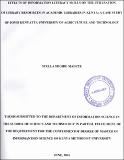| dc.description.abstract | Information literate students' access, retrieve, evaluate and put into use information from different sources. They communicate effectively and efficiently and reflect on the process as well as the product. However, students in most universities depend heavily on their lecture notes and library assistants to seek information despite having been taught information literacy skills during their fast year in the university (Kavulya, 2003). One is thus led to ask the question: Why are students not performing as expected regarding the application of information literacy skills? Therefore, the study sought to investigate the impact of information literacy programs on utilization of library resources at Jomo Kenyatta University of Agriculture and Technology, Mombasa Campus. The specific objectives of the study were to: find out the levels of information literacy skills among students; identify the role of libraries in the integration of information literacy programs; establish the methods used in the provision of an information literacy programs; and to find out the students' perceptions on information literacy programs. The study adopted the seven ways or faces of information literacy model by Bruce (1997). This study employed the descriptive and explanatory research designs. The study employed both non probability and probability sampling techniques. The study sample was stratified according to the level of education of the respondents and convenience sampling was used in administering the questionnaires. The study sample comprised 335 users and 2 librarians who were selected using purposive sampling.Data was analyzed descriptively using SPSS 23 and presented in form of tables and figures. The findings of the study showed that the majority of the respondents understood the meaning of information literacy, they used the OPAC system and E-resources to locate, access, retrieve and effectively use the information acquit ed. The methods employed in the teaching information literacy skills included carrying out annual orientation programs for new students, organizing library workshops and demonstrations. However, it was evident that majority of library users lacked information searching and retrieval skills and this was due to the fact that they did not undergo a well-organized information literacy program, and that university students rely heavily on the internet for their academic work or research. The study concluded that although there have been efforts to ensure information literacy among university students, there is need to build on these efforts through collaborative efforts between librarians and faculty members particularly through joint curriculum design and implementation. There are some forms of information literacy training in the institution, however the training offered was not adequate to promote lifelong learning due to lack of standardized information literacy programs and lack of information literacy policies. The fmdings of the study will be significant to the policy makers by helping them to make sound policies that will enhance the development of information literacy skills among university students. Various methods should be used for teaching and assessing the information literacy skills of the students, which includes: one-on-one instruction, interactive classes, online tutorials, as well as building assignments around research situations. Lecturers should also be encouraged to use e-library resources and computers as well as the Internet and online searching skills as part of the students' assignments. | en_US |

